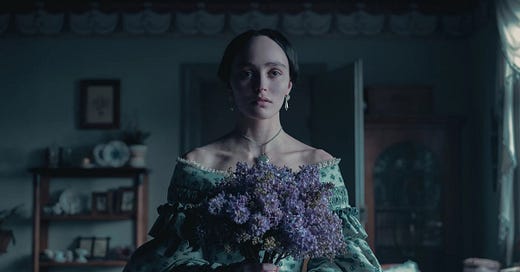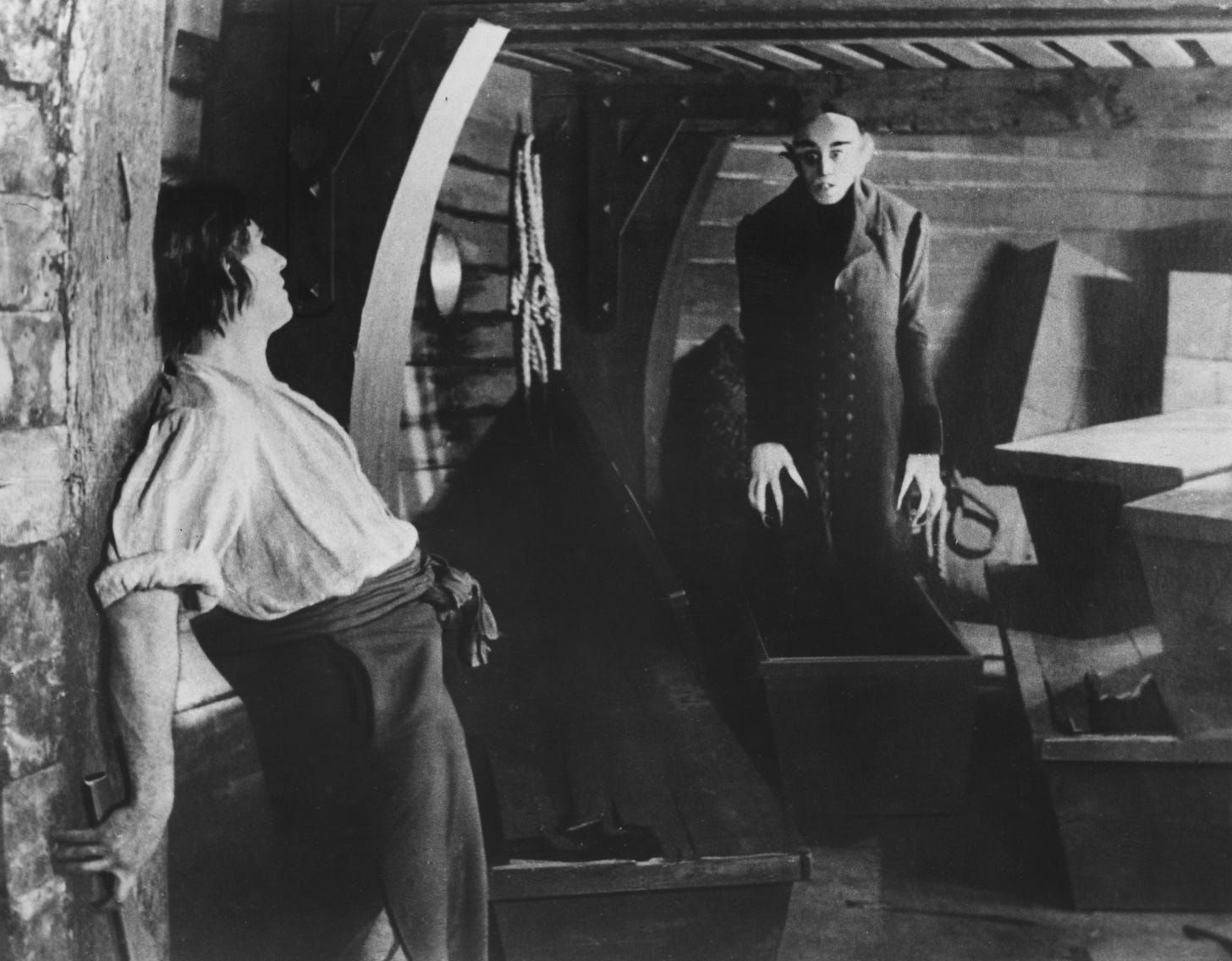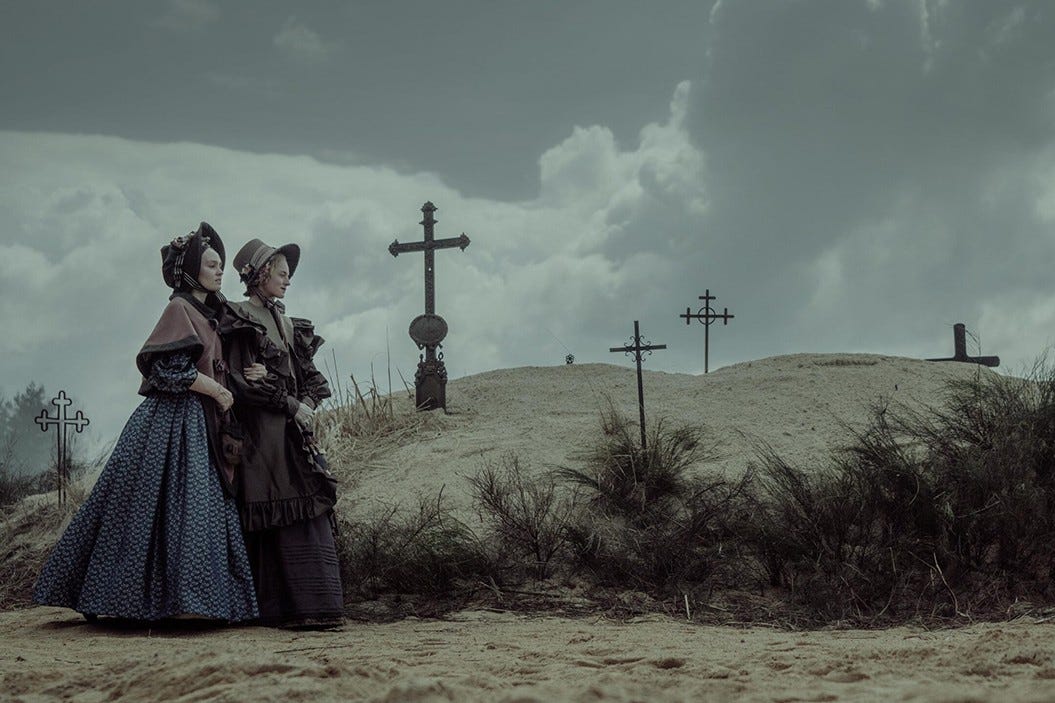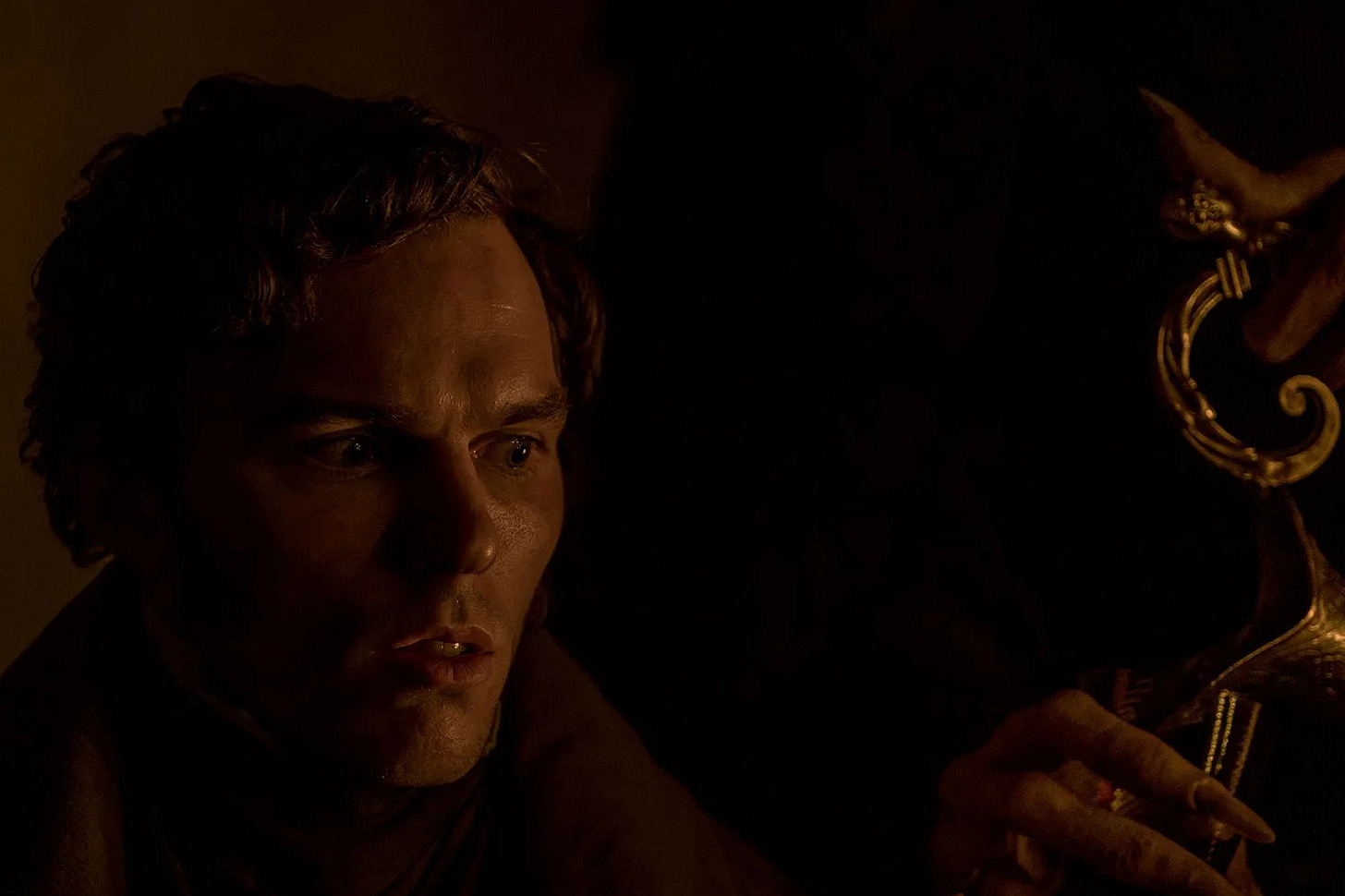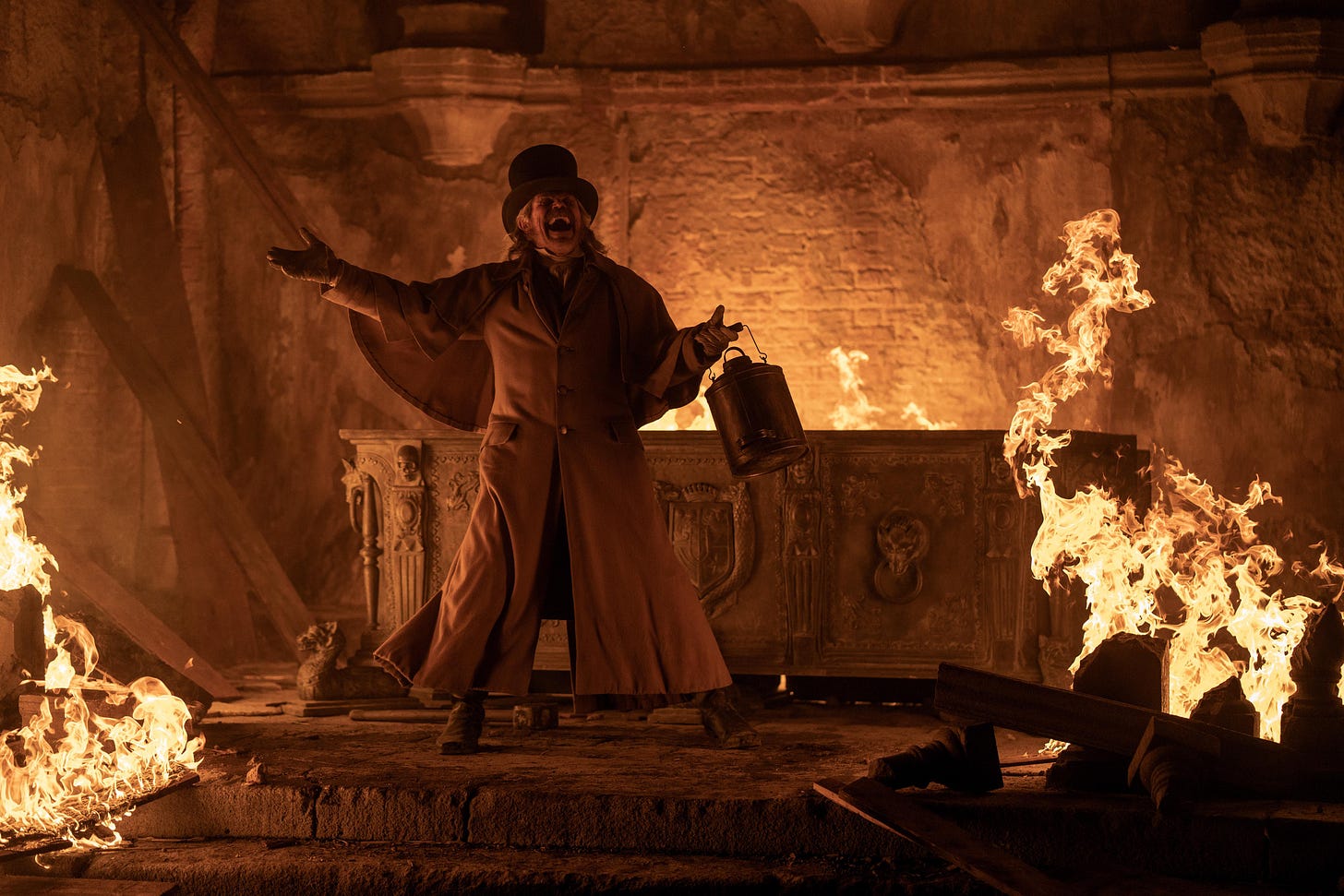Nosferatu Reflects the Beauty in Darkness
This modern iteration of the timeless classic was worth waiting for
Welcome to your Sunday Fluff at The Drip Tray: A weekly treat of fun and fandom to indulge your sweet tooth, like an artsy cappuccino.
Bram Stoker’s Dracula is a cornerstone of Gothic literature that has been adapted for the screen countless times since it was first published in 1897. The titular character, an ancient vampire driven by lust and greed, has been portrayed by such household names as Bela Lugosi, Sir Christopher Lee, Gary Oldman, and even Nicolas Cage. Suffice it to say, the story of Dracula is cemented in cinema just as much as it is in literature.
But F.W. Murnau’s silent German Expressionist film Nosferatu (1922), or Nosferatu: A Symphony of Horror, took only the bare bones of Stoker’s classic tale and constructed a much scarier narrative. He then realised it with chilling shadow play and unsettling body language to effectively communicate the fear of the novel’s characters in a mute visual format, which you can watch online for free. A 1979 remake with colour and sound by Werner Herzog, Nosferatu the Vampyre, brought it to the next generation and is considered one of horror’s finest.
The highly-anticipated interpretation from auteur Robert Eggers comes a hundred years after the original, yet still manages to feel fresh and interesting. Set in the 1830s, Nosferatu (2024) follows the treacherous journey of Thomas Hutter, played by Nicholas Hoult, through the Carpathian Mountains to meet Count Orlok, played by Bill Skarsgård, at his remote castle in Transylvania to sign the deed of an old house in Germany. Meanwhile, Thomas’ wife Ellen, played by Lily-Rose Depp, is besieged by prophetic nightmares that lead to a terrible union.
Eggers, who wrote and directed the film, is hugely influenced by the original and has cited it as one of his favourite movies of all time. People seem to love or hate his work and I fall into the former camp, with The Witch (2015) and The Lighthouse (2019) being some of the most unique horrors of the past decade in my opinion. Dracula was also the first classic novel that I remember reading, which sent me down a rabbit hole of discovery, so I had certain expectations going into this. I’ll tell you now, it definitely delivered.
I suppose I should start with how the film looks. It was shot in 1.66:1, instantly making the viewer feel claustrophobic despite the vast exterior settings. Colour grading is used to remove the saturation of daytime shots so that the film takes on Ellen’s sickly pallor – I wouldn’t be surprised if it was shot entirely with natural lighting. The warm incandescence of the interior shots symbolise the profuse love between Thomas and Ellen, which only inverts to the cold greyness of the snowy landscapes when Orlok or his sinister influence is present.
This allows for ominous shadows and deeper blacks, often hiding one half of a character’s face when directly in front of the camera to suggest an identity crisis raging within them. The most memorable moments are Orlok’s outline against the wispy white curtains flapping in the breeze, his great shadowy hand reaching across the town in an eerie aerial shot, and of course the iconic staircase homage approaching the bedroom door. Darkness plays a big part in the overall tone of the film and is exploited to evoke both vulnerability and safety.
The gliding camera movement and character blocking were also highlights of the subtly complex technique, courtesy of Academy Award-winning cinematographer Jarin Blaschke. I noticed numerous times that two characters would switch sides of the frame mid-conversation in a single shot. This created the sense of watching a stage show and made the slower scenes feel more theatrical and engaging. Not to mention that it lets you look around at the stunning set pieces of Gothic architecture – particularly Orlok’s castle – and leatherbound books.
This leads me to the overarching themes, which are somewhat hidden in plain sight if you look close enough. There’s a strange dichotomy between love and death that is shown as something to be simultaneously feared and embraced. Even the frameable final shot of the film is grotesque yet peaceful, a shameless dirge in the cold light of day. In a way, “Nosferatu” is Death incarnate, or could be interpreted as the manifestation of Ellen’s grief. It also seems that it is not blood that vampires crave but rather a corruption of innocence.
The strongest themes, however, are those of obsession and possession. The former in Orlok’s relentless pursuit of Ellen and her dark fantasies bleeding into reality; the latter in both the literal sense of the word – ownership, wealth, materialism – as well as a form of spiritual control. Orlok uses Ellen as a vessel to weaken her bond with Thomas and poison his thoughts with questions of her faith. One bedroom scene in particular was reminiscent of The Exorcist (1973), but with saliva instead of bile and a professor instead of a priest.
Speaking of how the final shot (among many) seem fit for a wall, these forbidden sexual desires call to mind the era of Romanticism. The striking visuals are clearly influenced by classic paintings of the 19th century, in which beautiful women are often splayed out by hellish creatures. Even the opening sequence of the film features Depp’s orgasmic moans and a later scene had me squirming in my seat with anticipation. To Eggers’ credit, the film rarely goes where you expect it to, instead conveying the horror (and lust) in a tasteful manner.
Hoult is phenomenal as the timorous everyman, with utterly convincing reactions reminiscent of his role in The Menu (2022). You can see a hundred different emotions play across his face in the close ups and the way that he trembles in Orlok’s wake when they first meet is pitiful. Depp, on the other hand, captivates with vehement monologues and displays a quiet suffering in her forlorn thousand-yard stare. She radiates innocence with her tightly-braided hair and immaculate pale skin, yet harbours unspeakable feelings that inevitably come tumbling out.
Both leads deliver in their own unique ways and are only complimented by circumstance. The scenes in which Ellen is possessed by Orlok border on the comical, but the fear it creates in the surrounding characters is reflected onscreen. Aaron Taylor-Johnson, Willem Dafoe, and Ralph Ineson are committed to their supporting roles, embracing the vernacular of the era with gusto and sincerity. Honestly, the compelling performances and palpable chemistry of such an attractive cast are largely to thank for the fluency of the film’s enduring runtime.
But of course, the world was most excited to get a brand new look at the monster. Skarsgård fully embraces the honourably cumbersome duty of playing such a character, one of the greatest villains in cinema history. His intimidating figure lurks in the shadowy background, complete with gnarled fingers and a much-maligned mo (it’s a yes from me). The enunciated Romanian drawl reminds of Darth Vader with a death rattle and the hideous gulping sounds when drinking the blood of his victims is nauseating. All that practice as Pennywise paid off.
While it follows the source material closely, there were some minor changes. In the original, for example, Orlok’s presence is suggested by his victims falling ill with two small holes in their necks, which people suspect to be from mosquitos or rat bites. In this version, the town is ravaged by a literal albeit mystical plague from vermin aboard the ship transporting him to Germany that causes people to violently vomit blood. Nevertheless, there’s lots of stringy bodily fluids and a few gory moments to keep the horror fans entertained.
But at its heart, Nosferatu is a dark fairytale. Four brave men band together to banish evil from their homeland and rescue a damsel in distress, though Eggers ensures that the story doesn’t have a happy ending. All of his films are period pieces exploring the minutiae of hardship through the eyes of disturbed individuals. This sense of realism is often paradoxically blended with the supernatural in Eggers’ work, leaving the viewer to question their own reality and wrestle with existential dread at the ambiguous reveal.
Nosferatu was one of the most awaited films of 2024 and it certainly lived up to its reputation. Its artistic prowess and unconventionality has canonised Eggers as the auteur of a generation who can be trusted with beloved cultural mainstays like Dracula. From the bold imagery and haunting score to the brilliant performances and resonant message, this is a commendable remake and a great feat of Gothic horror.


